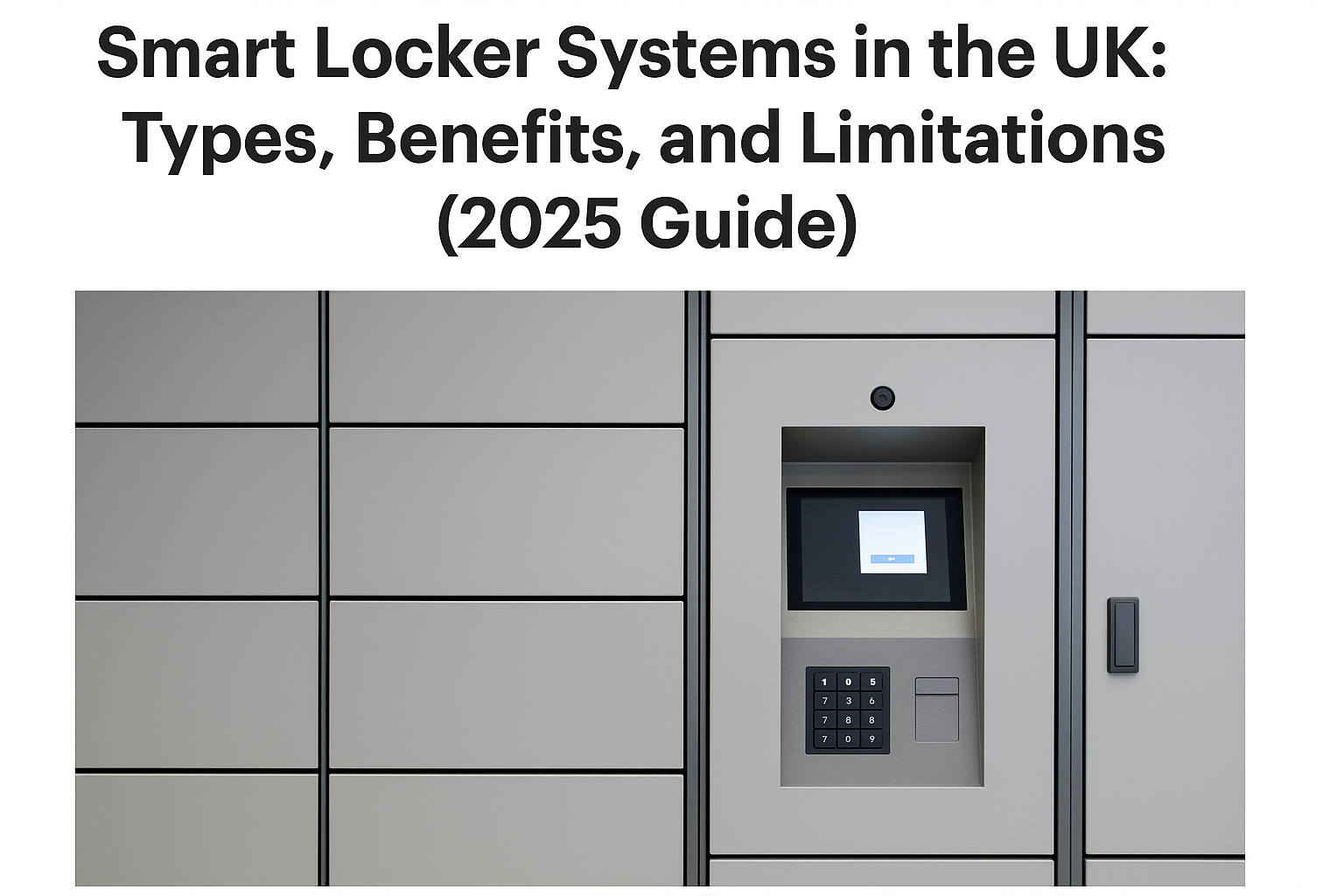Choosing the right secure storage solution represents one of the most critical decisions for facilities managers today. Moreover, modern storage technology has evolved dramatically to meet changing security requirements. Additionally, organisations across all sectors now demand sophisticated storage systems that combine security, convenience, and technological innovation. Therefore, understanding the complete landscape of storage solutions helps businesses make informed investment decisions.
This comprehensive guide examines every aspect of secure storage for modern facilities. Furthermore, we explore traditional security safes, innovative locker systems, advanced locking mechanisms, and cutting-edge AI-powered storage management. Consequently, readers will gain practical knowledge to select optimal storage solutions for their specific requirements.
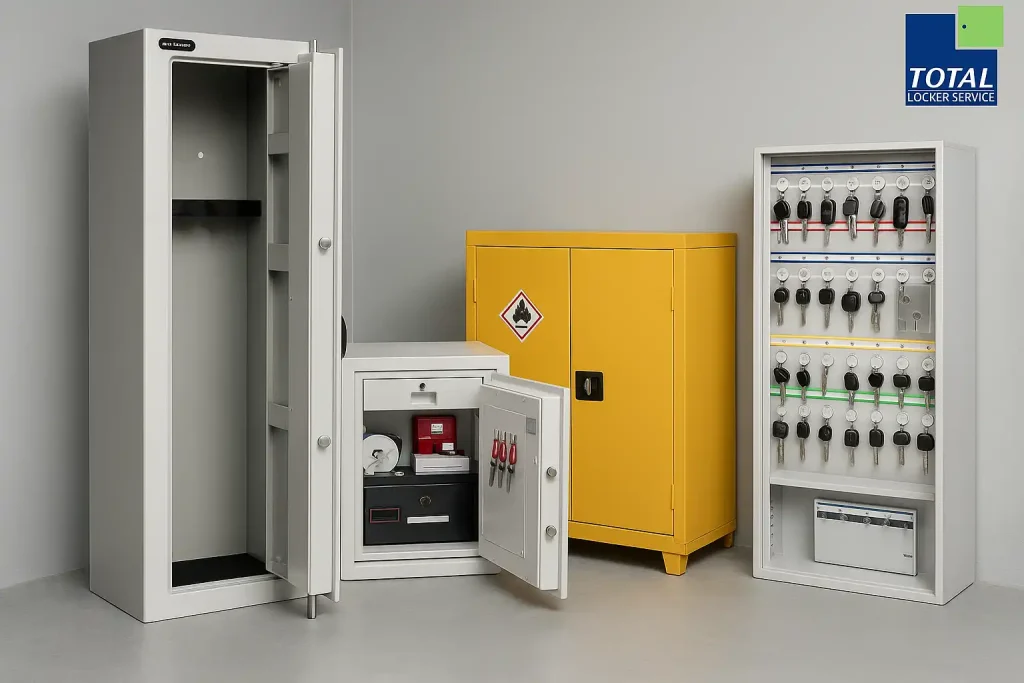
Understanding Modern Secure Storage Requirements
Security needs have transformed significantly over the past decade. Additionally, facilities now face complex challenges that extend beyond simple theft prevention. Furthermore, regulatory compliance, data protection, and user convenience create competing demands that storage solutions must address simultaneously. Therefore, modern storage systems integrate multiple security layers whilst maintaining operational efficiency.
Different facility types demand tailored storage approaches based on their unique operational requirements. For instance, educational institutions prioritise durability and ease of maintenance. Moreover, healthcare facilities require hygienic solutions with strict access control. Subsequently, corporate environments focus on professional appearance and technological integration. Consequently, successful storage implementations require careful analysis of specific facility needs.
The Evolution of Storage Security Standards
Security standards have evolved considerably to address emerging threats and technological advances. Additionally, international rating systems now provide clear guidance for storage security levels. Furthermore, facilities can select appropriate solutions based on standardised protection ratings. Therefore, understanding these standards ensures adequate protection for valuable assets.
Modern storage solutions incorporate multiple protection technologies that work together seamlessly. Moreover, physical security features combine with electronic monitoring and access control systems. Subsequently, integrated security approaches provide comprehensive protection against various threat types. Additionally, regular security audits ensure storage systems maintain effectiveness over time.
Comprehensive Guide to Security Safes and Protective Storage
Security safes remain fundamental components of comprehensive storage security strategies. Additionally, modern safes incorporate advanced features that address specific protection requirements. Furthermore, understanding different safe types helps facilities select appropriate solutions for various assets. Therefore, examining safe categories provides essential knowledge for informed purchasing decisions.
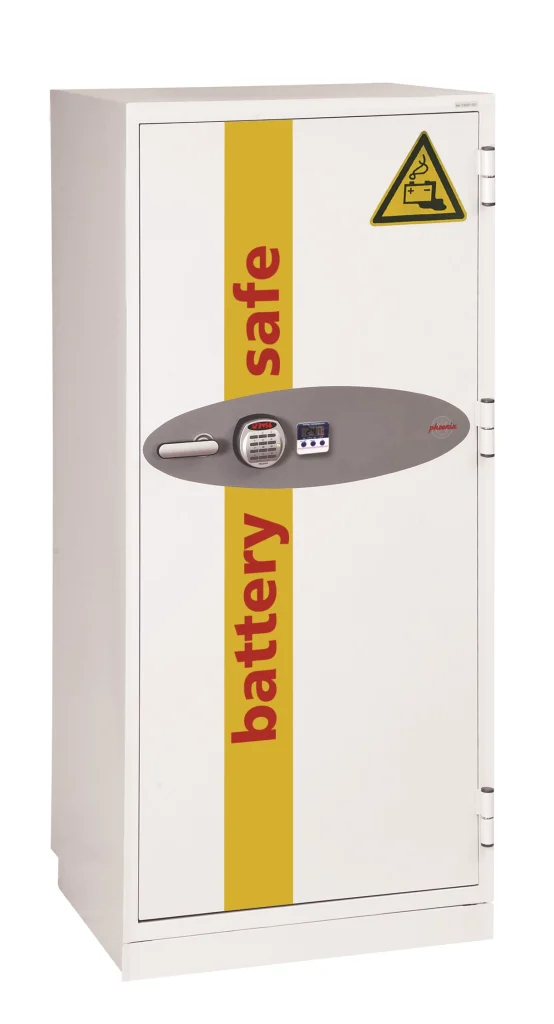
Fire-Resistant Storage Solutions
Fire-resistant safes offer critical protection during emergency situations that could destroy valuable documents and assets. Moreover, these units maintain lower internal temperatures through specialised insulation materials such as gypsum and ceramic. Additionally, different fire ratings provide varying protection durations ranging from one hour to three hours. Subsequently, organisations must select appropriate ratings based on potential fire exposure risks.
However, fire-resistant safes present certain limitations that facilities must consider carefully. Specifically, these units typically use thinner gauge steel in their construction to accommodate insulation materials. Furthermore, this design prioritises fire protection over burglary resistance. Moreover, standard fire-resistant safes cannot adequately protect electronic media from heat and humidity damage. Therefore, specialised data protection storage becomes necessary for digital assets.
Burglary-Resistant Security Storage
Burglary-resistant safes provide maximum protection against sophisticated attack methods. Additionally, these units feature thick steel walls and advanced locking mechanisms that resist drilling, prying, and cutting. Furthermore, security ratings such as B-rate, C-rate, and TL ratings indicate different protection levels. Consequently, higher ratings signify greater resistance to determined theft attempts.
Construction quality determines burglary-resistant safe effectiveness significantly. Moreover, quality units incorporate multiple steel layers and reinforced door systems. Additionally, many models include re-locking devices that engage automatically when tampering occurs. Subsequently, these sophisticated features provide excellent protection for high-value assets. However, burglary-resistant models typically lack fire protection capabilities unless specifically designed as combination units.
Specialised Storage for Firearms
Firearm storage requires specific features that ensure both security and legal compliance. Additionally, quality gun safes use heavier twelve-gauge steel in body construction for superior protection. Furthermore, door construction proves particularly critical with quarter-inch solid plate steel representing minimum acceptable thickness. Moreover, capacity planning requires purchasing safes approximately fifty per cent larger than current collections to accommodate growth.
Locking mechanisms for firearm storage include biometric systems, electronic keypads, and traditional dial locks. Additionally, each option offers different advantages regarding speed, reliability, and durability. Furthermore, biometric locks provide rapid access but can prove finicky in dusty environments. Moreover, electronic keypads balance speed with reliability effectively. Subsequently, dial locks offer maximum durability without battery requirements.
Data and Media Protection Storage
Electronic media requires specialised protection beyond standard fire-resistant capabilities. Additionally, temperature and humidity control prove critical for preserving magnetic media and digital storage devices. Furthermore, data safes maintain precise environmental conditions that prevent corruption from heat exposure. Therefore, organisations storing important digital assets must invest in specialised data protection storage.
Standard fire-resistant units cannot adequately protect electronic media due to their temperature tolerance limitations. Moreover, magnetic media particularly requires careful environmental management throughout storage. Subsequently, specialised data storage units incorporate sophisticated climate control systems. Additionally, these units often provide organised compartments for different media types and formats.
Modern Locker Systems for Diverse Applications
Locker systems serve essential storage functions across numerous facility types and applications. Additionally, modern lockers incorporate advanced materials and security features that address evolving requirements. Furthermore, understanding different locker types helps facilities select appropriate solutions for their specific needs. Therefore, examining locker categories provides valuable guidance for storage planning.
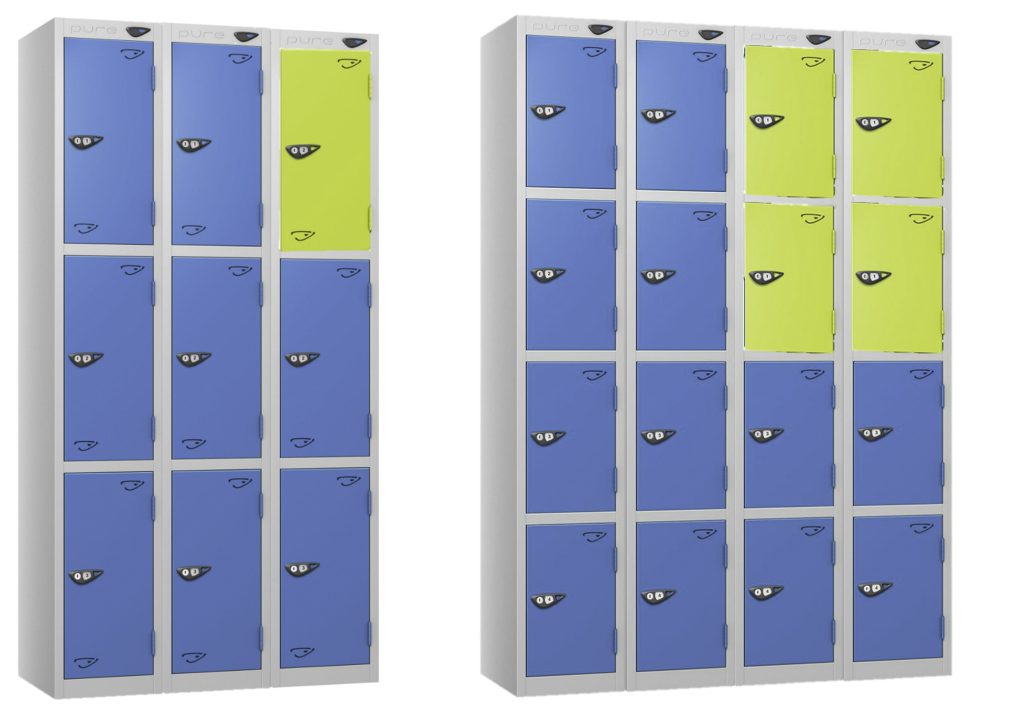
Educational Institution Lockers
School lockers must withstand intensive daily use whilst providing reliable security for students. Additionally, educational facilities require durable construction that resists impact and vandalism. Furthermore, various sizes and configurations accommodate different age groups and storage requirements. Moreover, colour options help create positive learning environments and support wayfinding.
Maintenance considerations prove particularly important for educational settings. Subsequently, robust construction minimises repair requirements throughout extended service life. Additionally, easy-clean surfaces reduce maintenance time and costs significantly. Furthermore, standardised components enable economical repairs and part replacements when necessary.
Workplace and Office Lockers
Corporate environments demand lockers that balance security with professional appearance. Additionally, workplace lockers accommodate personal belongings, electronic devices, and confidential documents. Furthermore, advanced locking mechanisms provide appropriate security levels for different storage requirements. Moreover, sleek designs complement modern office aesthetics whilst providing practical functionality.
Workplace lockers increasingly incorporate technology integration features such as device charging capabilities. Subsequently, laptop and tablet charging lockers address modern workforce requirements effectively. Additionally, these specialised lockers include secure power connections and cable management systems. Therefore, technology-enabled lockers support productive work environments.
Leisure and Fitness Facility Lockers
Gym and leisure centre lockers face unique challenges from humid environments and intensive use. Additionally, waterproof and corrosion-resistant materials ensure long-term reliability in wet conditions. Furthermore, ventilation features prevent moisture build-up and maintain hygienic storage conditions. Moreover, durable construction withstands impact from sports equipment and heavy items.
Locking solutions for leisure facilities must accommodate diverse user preferences and temporary usage patterns. Subsequently, coin-return locks provide convenient pay-per-use options for public facilities. Additionally, swivel hasp systems allow users to bring their own padlocks. Furthermore, electronic locks enable managed access control for membership environments.
Healthcare Facility Lockers
Medical facilities require hygienic locker solutions that meet strict cleanliness standards. Additionally, easy-clean surfaces prevent bacterial accumulation and support infection control protocols. Furthermore, healthcare lockers must comply with relevant industry regulations and safety standards. Moreover, secure storage protects staff personal belongings and sensitive materials.
Specialised features for healthcare lockers include antimicrobial coatings and seamless construction. Subsequently, these design elements minimise cleaning challenges whilst maintaining sterile environments. Additionally, colour-coded systems support departmental organisation and wayfinding. Therefore, healthcare lockers must balance hygiene requirements with practical functionality.
Advanced Locking Mechanisms for Modern Security
Locking systems represent critical components that determine storage security effectiveness. Additionally, modern locking technology offers diverse options addressing different security requirements and user preferences. Furthermore, understanding locking mechanism types helps facilities select appropriate solutions. Therefore, examining lock categories provides essential knowledge for security planning.
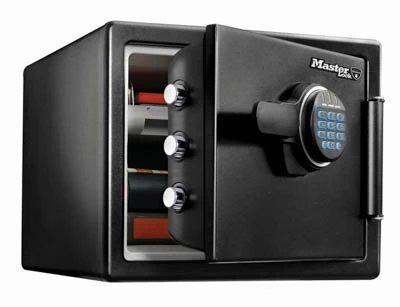
Traditional Key-Operated Lock Systems
Key-operated locks provide proven security through mechanical simplicity and reliability. Additionally, these systems require no electrical power and function independently of electronic systems. Furthermore, high-quality key locks feature hardened steel components and complex pin configurations. Moreover, their mechanical nature eliminates electronic vulnerabilities that could compromise security.
However, key systems present certain management challenges that facilities must address. Specifically, lost keys create security vulnerabilities and replacement costs. Additionally, key duplication control proves difficult without sophisticated master key systems. Furthermore, emergency access requires maintaining secure master key procedures. Therefore, key management protocols become essential for effective security.
Combination Lock Systems
Combination locks eliminate key management concerns through code-based access control. Additionally, users can set personalised codes that provide customised security. Furthermore, master override capabilities enable administrative access during emergencies. Moreover, combination locks suit environments where multiple users share storage spaces.
Mechanical combination locks offer durability without battery requirements or electronic components. Subsequently, these locks function reliably in challenging environments including outdoor applications. Additionally, code retrieval systems enable administrators to recover forgotten combinations efficiently. Therefore, combination locks provide practical security for various facility types.
Electronic Keypad Lock Solutions
Electronic keypad locks combine security with operational flexibility through programmable access codes. Additionally, these systems support multiple user codes with different access privileges. Furthermore, audit trail capabilities track access events for security monitoring. Moreover, remote management features enable centralised control across multiple locations.
Battery-powered electronic locks eliminate hardwiring requirements whilst maintaining reliable operation. Subsequently, low-battery alerts prevent unexpected lockouts and service interruptions. Additionally, backup mechanical keys provide emergency access options. Therefore, electronic keypads balance convenience with comprehensive security features.
Biometric Authentication Systems
Biometric locks provide maximum security through fingerprint or facial recognition technology. Additionally, these systems eliminate key management and code-sharing concerns entirely. Furthermore, biometric authentication prevents unauthorised access attempts effectively. Moreover, rapid recognition enables quick access without compromising security.
However, biometric systems require careful environmental consideration for optimal performance. Specifically, dusty or humid conditions can affect sensor reliability. Additionally, these systems typically require electrical power and regular cleaning. Furthermore, biometric locks represent premium security solutions with corresponding investment requirements.
RFID and Contactless Access Systems
Radio-frequency identification locks enable convenient contactless access through cards or fobs. Additionally, RFID systems integrate seamlessly with facility access control infrastructure. Furthermore, lost cards can be deactivated remotely without changing physical locks. Moreover, usage tracking provides valuable security and operational data.
RFID technology supports sophisticated access management including time-based restrictions and temporary access grants. Subsequently, facilities can implement flexible security policies that adapt to changing requirements. Additionally, integration with visitor management systems enables seamless guest access control. Therefore, RFID locks suit complex facilities with diverse access requirements.
Swivel Hasp Systems for User-Controlled Security
Swivel hasp systems allow users to provide their own padlocks for personalised security control. Additionally, these systems eliminate facility key management responsibilities entirely. Furthermore, hasp systems accommodate various padlock types including combination, keyed, and electronic options. Moreover, simple construction ensures reliability and durability in demanding environments.
However, swivel hasp systems depend entirely on user-provided padlock quality for security effectiveness. Subsequently, security levels may vary considerably across different lockers. Additionally, users must remember to bring appropriate padlocks for each facility visit. Therefore, hasp systems suit environments where user responsibility aligns with operational requirements.
Innovative Postage Locker Solutions for Package Management
Postage lockers represent revolutionary solutions addressing modern package delivery challenges. Additionally, these automated systems provide secure storage for parcels of various sizes. Furthermore, twenty-four-hour accessibility eliminates delivery scheduling frustrations for busy recipients. Therefore, postage lockers have become essential infrastructure for residential and commercial properties.
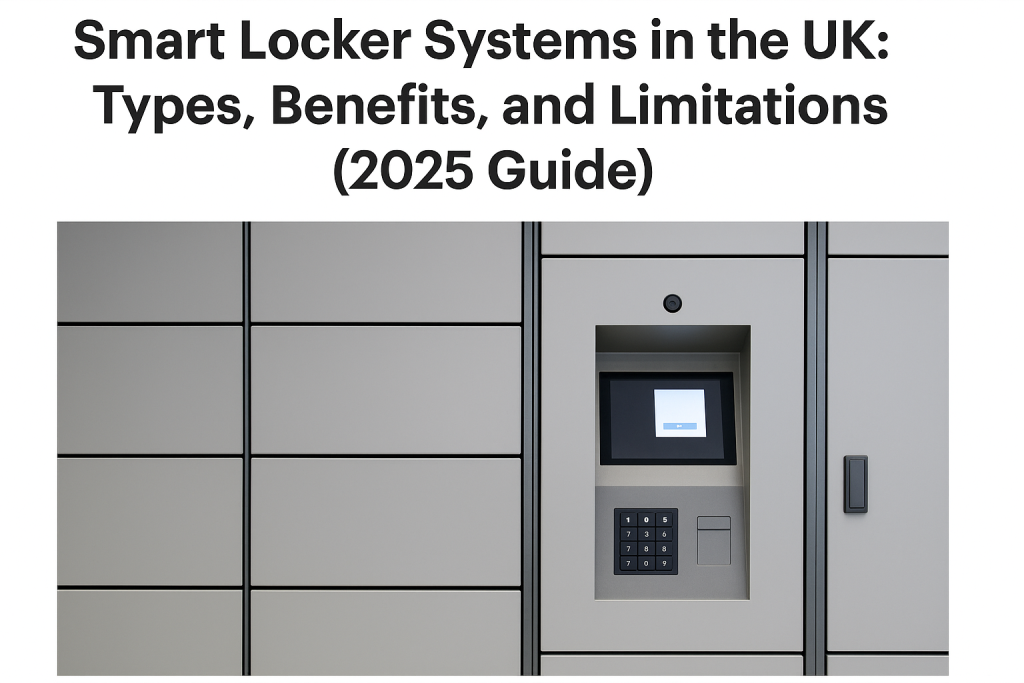
Benefits of Automated Package Storage
Package delivery efficiency improves dramatically with centralised locker systems. Moreover, delivery drivers complete multiple deliveries to single locations rapidly. Subsequently, reduced delivery times lower operational costs whilst improving service reliability. Additionally, recipients enjoy flexible collection times that accommodate varied schedules.
Environmental benefits emerge from consolidated delivery patterns enabled by postage lockers. Furthermore, fewer delivery attempts reduce carbon emissions from delivery vehicles significantly. Moreover, optimised routes minimise fuel consumption and transportation impact. Therefore, postage lockers support sustainability objectives whilst improving delivery services.
Postage Locker Size and Configuration Options
Multiple compartment sizes accommodate diverse package dimensions effectively. Additionally, small compartments handle electronics, clothing, and compact items efficiently. Furthermore, medium compartments suit standard retail packages and gift deliveries. Moreover, large compartments enable secure storage for appliances and oversized items.
Flexible configurations maximise available space whilst meeting varied delivery requirements. Subsequently, adjustable systems adapt to changing package size distributions over time. Additionally, strategic size distribution optimises system utilisation and customer satisfaction. Therefore, careful capacity planning ensures effective postage locker performance.
Technology Integration and Smart Features
Advanced software platforms provide comprehensive management and real-time monitoring capabilities. Additionally, mobile applications enable convenient package notifications and collection instructions. Furthermore, remote management systems allow centralised control across multiple locations. Moreover, usage analytics provide valuable insights for capacity planning and optimisation.
Security features including multi-factor authentication ensure only authorised recipients access packages. Subsequently, audit trails track all access events for security and accountability purposes. Additionally, surveillance integration provides additional protection against theft and misuse. Therefore, comprehensive security measures build customer trust and confidence.
Artificial Intelligence Transforming Storage Management
Artificial intelligence represents the cutting edge of storage management technology. Additionally, AI systems process vast data quantities to optimise storage operations continuously. Furthermore, machine learning algorithms improve efficiency through predictive analytics and pattern recognition. Therefore, AI-powered storage solutions deliver unprecedented performance and cost-effectiveness.
Predictive Analytics for Inventory Optimisation
Predictive analytics tools forecast future inventory requirements based on historical data analysis. Additionally, these systems account for seasonal trends, promotional activities, and market conditions. Furthermore, machine learning models continuously improve accuracy through ongoing data analysis. Moreover, predictive capabilities help maintain optimal stock levels whilst minimising carrying costs.
Real-time data integration enables dynamic inventory adjustments responding to current conditions. Subsequently, businesses can prevent stockouts whilst avoiding excess inventory accumulation. Additionally, slow-moving inventory identification enables proactive management strategies. Therefore, predictive analytics delivers significant operational and financial benefits.
Computer Vision for Quality Control
Computer vision technology enables automated quality inspection throughout storage operations. Additionally, high-resolution cameras and image processing algorithms identify defects and damage automatically. Furthermore, these systems verify product authenticity and storage compliance continuously. Moreover, computer vision operates twenty-four hours daily without human intervention.
Integration with storage management systems enables automatic routing decisions based on quality assessments. Subsequently, damaged items receive appropriate handling preventing customer dissatisfaction. Additionally, quality data informs handling procedures and storage condition requirements. Therefore, computer vision maintains consistent quality standards throughout storage operations.
Machine Learning for Route Optimisation
Machine learning algorithms optimise picking routes and material handling paths within facilities. Additionally, these systems analyse facility layouts, product locations, and order patterns continuously. Furthermore, dynamic optimisation considers real-time factors including equipment availability and congestion. Moreover, machine learning identifies opportunities for layout improvements over time.
Mobile device integration provides real-time route guidance to warehouse staff. Subsequently, workers follow optimised paths that minimise travel time and improve productivity. Additionally, performance tracking identifies improvement opportunities and training needs. Therefore, machine learning delivers continuous operational efficiency improvements.
Natural Language Processing for Documentation Management
Natural language processing tools manage vast documentation quantities associated with storage operations. Additionally, automated document processing reduces manual data entry and associated errors. Furthermore, NLP technology extracts relevant information from unstructured data sources efficiently. Moreover, voice recognition enables hands-free system interaction and data entry.
Document classification and routing based on content analysis streamlines administrative workflows. Subsequently, automated summary generation provides quick information access from complex documentation. Additionally, translation capabilities support multilingual operations seamlessly. Therefore, NLP technology significantly improves documentation efficiency and accuracy.
Implementing Integrated Storage Security Systems
Successful storage security requires integrating multiple technologies and approaches into cohesive systems. Additionally, comprehensive planning ensures all security elements work together effectively. Furthermore, professional implementation prevents security gaps and operational inefficiencies. Therefore, structured implementation methodologies deliver optimal security outcomes.
Security Assessment and Requirements Analysis
Implementation begins with thorough assessment of existing security measures and identified vulnerabilities. Additionally, stakeholder interviews reveal specific requirements and operational constraints. Furthermore, threat analysis determines appropriate security levels for different asset types. Moreover, regulatory compliance requirements influence security solution selection.
Documentation of current processes identifies opportunities for security improvements and efficiency gains. Subsequently, gap analysis highlights areas requiring immediate attention versus long-term enhancements. Additionally, prioritisation frameworks ensure critical security needs receive appropriate resources. Therefore, comprehensive assessment provides solid foundations for security planning.
Technology Selection and System Design
Technology selection balances security requirements with budget constraints and operational considerations. Additionally, compatibility with existing systems influences technology choices significantly. Furthermore, scalability requirements ensure selected solutions accommodate future growth. Moreover, vendor evaluation considers support capabilities and long-term viability.
System design integrates selected technologies into cohesive security architectures. Subsequently, detailed specifications guide installation and configuration activities. Additionally, redundancy planning prevents single points of failure compromising security. Therefore, thoughtful design ensures reliable and effective security systems.
Installation and Commissioning Procedures
Professional installation ensures systems function according to design specifications and security requirements. Additionally, qualified technicians understand local regulations and compliance requirements thoroughly. Furthermore, proper installation minimises future maintenance needs and operational problems. Moreover, comprehensive testing validates system functionality before operational deployment.
Commissioning procedures verify all system components operate correctly and integrate seamlessly. Subsequently, performance testing confirms systems meet specified requirements and expectations. Additionally, documentation provides essential information for ongoing system management. Therefore, thorough commissioning ensures successful system deployment.
Training and Change Management
Comprehensive training programmes prepare staff for new system operation and maintenance. Additionally, role-specific training addresses different user needs and responsibilities effectively. Furthermore, hands-on practice builds confidence and competence with new technologies. Moreover, ongoing training supports continuous improvement and skill development.
Change management strategies help organisations adapt to new security systems and procedures. Subsequently, communication programmes explain benefits and address concerns proactively. Additionally, feedback mechanisms enable continuous improvement of training and procedures. Therefore, effective change management ensures successful technology adoption.
Maintenance and Long-Term System Management
Ongoing maintenance ensures storage security systems remain effective throughout their operational life. Additionally, preventive maintenance prevents costly failures and service interruptions. Furthermore, regular inspections identify wear patterns and potential issues early. Therefore, systematic maintenance programmes protect security investments and optimise performance.
Preventive Maintenance Schedules
Scheduled maintenance activities preserve system functionality and extend equipment lifespan. Additionally, lubrication, adjustment, and cleaning procedures maintain optimal operation. Furthermore, component replacement schedules prevent unexpected failures during critical periods. Moreover, maintenance records provide valuable information for system management and planning.
Predictive maintenance technologies identify potential failures before they occur. Subsequently, condition monitoring enables proactive maintenance scheduling and resource allocation. Additionally, data analysis reveals patterns that inform maintenance strategy improvements. Therefore, advanced maintenance approaches maximise system reliability and availability.
Performance Monitoring and Optimisation
Continuous monitoring tracks system performance against established benchmarks and expectations. Additionally, usage analytics reveal patterns that inform operational decisions. Furthermore, incident tracking identifies recurring problems requiring systematic solutions. Moreover, performance data supports evidence-based improvement initiatives.
Regular performance reviews assess system effectiveness and identify enhancement opportunities. Subsequently, benchmarking against industry standards reveals competitive positioning. Additionally, technology assessments determine when upgrades deliver meaningful benefits. Therefore, ongoing performance management ensures systems remain effective and competitive.
Security Audits and Compliance Verification
Periodic security audits verify systems maintain adequate protection against evolving threats. Additionally, compliance verification ensures continued adherence to regulatory requirements. Furthermore, vulnerability assessments identify potential weaknesses requiring remediation. Moreover, penetration testing validates security effectiveness under simulated attack conditions.
Audit findings guide security improvement initiatives and investment priorities. Subsequently, corrective actions address identified vulnerabilities systematically. Additionally, audit documentation demonstrates due diligence and regulatory compliance. Therefore, regular audits maintain security effectiveness and stakeholder confidence.
Future Trends in Secure Storage Technology
Storage security technology continues evolving rapidly with emerging innovations promising enhanced capabilities. Additionally, industry trends indicate increasing integration of artificial intelligence and automation. Furthermore, sustainability considerations influence technology development and selection decisions. Therefore, understanding future trends helps organisations plan strategic investments effectively.
Internet of Things Integration
Internet of Things technology enables unprecedented connectivity between storage devices and management systems. Additionally, sensor networks provide real-time environmental monitoring and condition tracking. Furthermore, automated alerts notify managers of potential issues requiring attention. Moreover, IoT integration supports predictive maintenance and optimised operations.
Smart storage solutions adapt automatically to changing conditions and requirements. Subsequently, energy management systems optimise power consumption without compromising security. Additionally, integration with building management systems creates comprehensive facility control. Therefore, IoT technology delivers significant operational benefits and efficiency improvements.
Blockchain for Enhanced Security and Transparency
Blockchain technology provides tamper-proof records of access events and system activities. Additionally, distributed ledger systems enhance transparency throughout storage operations. Furthermore, smart contracts automate compliance verification and access authorisation. Moreover, blockchain integration supports supply chain visibility and asset tracking.
Decentralised security approaches reduce single points of failure and enhance system resilience. Subsequently, blockchain technology enables new security paradigms and operational models. Additionally, integration with existing systems remains challenging but increasingly practical. Therefore, blockchain represents promising future enhancement for storage security.
Quantum-Resistant Security Technologies
Quantum computing threatens traditional encryption methods requiring new security approaches. Additionally, quantum-resistant algorithms protect against future computational capabilities. Furthermore, forward-thinking organisations implement quantum-safe security measures today. Moreover, industry standards for post-quantum cryptography continue developing rapidly.
Migration strategies balance current security needs with future quantum threats effectively. Subsequently, phased implementation approaches minimise disruption whilst enhancing protection. Additionally, vendor engagement ensures access to latest quantum-resistant technologies. Therefore, proactive planning protects storage security investments against emerging threats.
Selecting the Right Storage Security Partner
Choosing experienced storage security providers significantly influences implementation success and long-term satisfaction. Additionally, established suppliers offer comprehensive product ranges addressing diverse requirements. Furthermore, professional installation and support services ensure optimal system performance. Therefore, partner selection represents critical decisions deserving careful consideration.
Reputable suppliers demonstrate extensive industry experience and technical expertise. Moreover, they provide references and case studies showing successful implementations. Additionally, comprehensive warranties and support agreements protect customer investments. Furthermore, ongoing training and consultation services support continuous improvement.
Companies like Total Locker Service exemplify professional storage solution providers offering complete product ranges and expert guidance. Additionally, they supply everything from traditional safes to cutting-edge AI-powered systems. Furthermore, their comprehensive support services ensure customers achieve maximum value from storage investments.
Conclusion: Building Comprehensive Storage Security Strategies
Effective storage security requires integrating multiple technologies and approaches into cohesive strategies. Additionally, successful implementations balance security requirements with operational needs and budget constraints. Furthermore, professional planning and execution ensure systems deliver expected benefits throughout their operational life. Therefore, comprehensive storage security strategies protect assets whilst supporting efficient operations.
Modern facilities benefit from diverse storage solutions including traditional safes, advanced locker systems, sophisticated locking mechanisms, and AI-powered management platforms. Moreover, each component contributes unique capabilities that enhance overall security effectiveness. Subsequently, integrated approaches provide comprehensive protection addressing multiple threat types simultaneously. Additionally, scalable solutions accommodate growth and changing requirements over time.
Investment in quality storage security delivers substantial benefits including asset protection, regulatory compliance, operational efficiency, and stakeholder confidence. Furthermore, partnering with experienced suppliers ensures access to latest technologies and professional support services. Moreover, ongoing maintenance and optimisation maximise system performance and return on investment. Therefore, strategic storage security investments provide lasting value and competitive advantage.
Organisations planning storage security improvements should begin with comprehensive requirements analysis and threat assessment. Additionally, engaging qualified suppliers early provides valuable insights and guidance. Furthermore, phased implementation approaches manage costs whilst delivering progressive improvements. Consequently, thoughtful planning and professional execution ensure storage security investments achieve strategic objectives effectively.
